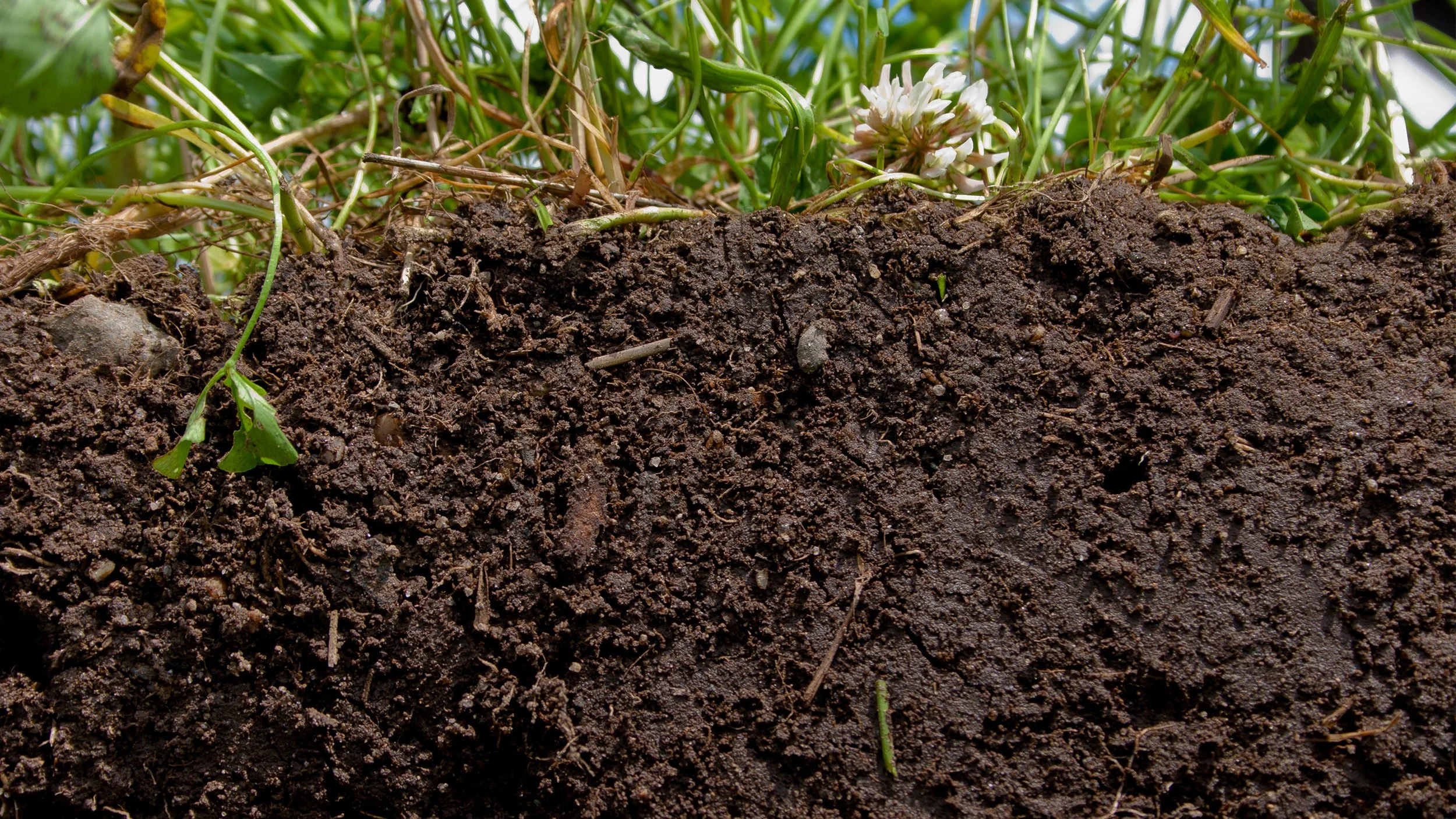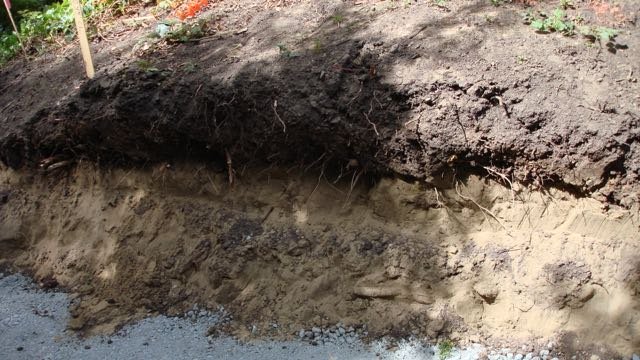SOIL
In this episode we introduce some fundamental aspects of soil. Later we will report on the nature of the soil of Bishops meadow. The nature of an area’s soil can be useful in understanding what sort of ecosystem it may potentially support.
Soil is not one thing, in fact it is an extremely complicated, shifting natural amalgamation. Not only are there all manner of soils in terms of composition but it is a layer that combines all three states of matter: solid, liquid and gas, a huge microscopic biomass and macroscopic plants and animals. Generally speaking, soil is formed from weathering of bedrock and therefore reflects the chemical composition of the bedrock. The most notable exceptions are organic [peat] soils and delta soils which deposit from distant bedrock. As a flood plain much of Bishops meadow soil comes down the river but it is made up of local bedrock because the drainage basin is small.
The basic characterization of a soil is done with two perspectives. One is identifying layers, the other is detailing what makes up the layers. There are three soil ‘horizons’ called, with science’s well recognized flair for names, A, B and C. They can be subdivided and usually have an organic decomposition layer [leaf mould for example] above. On top, horizon A is a zone of decomposition and then leaching of nutrients. Below, horizon B is a a zone of deposition of the nutrients and horizon C comprises ‘overburden’ or glei, a clay-based structure-less mass. Nutrient recycling is based on plant roots taking up the nutrients from the B horizon that have decomposed then leached from the A horizon and from the C horizon that have weathered from bedrock and supplying the nutrients to the above-surface parts of the plant. The soft parts of the plant as well as deadwood, depending on the ecosystem involved, subsequently fall to the ground to be decomposed thus completing the cycle.
The other analysis is based on particle size. A soil core is divided into layers, these are oven-dried, weighed, powdered in a ball mill and placed on top of a column of sieves of different mesh sizes on a shaker. After perhaps 24h, the contents of each sieve is weighed to determine the proportion of clay [<.002mm]; silt [.002 - .05mm]; very fine sand [.05 - .1mm] through fine sand, medium sand, coarse sand, fine gravel up to coarse gravel [>2mm], pebbles and cobbles.
Aside from this characterization, chemical features of soil are also important parameters. pH is a measure of acidity / alkalinity. I won’t offer a formal explanation of exactly what pH is but suffice to say, the pH scale goes from 1 [maximally acidic] to 14 [maximally alkaline] and 7 is neutral. It is NOT an arbitrary scale and relates to water’s ability to dissolve in itself. A strong acid is no more corrosive than a strong base although they do not effect a given material in the same way. Some plants are adapted to low pH such as blueberry, some to high pH such as asparagus. Neither state is inherently better but the mobility of some nutrients within the soil, most notably phosphorus and the metallic micronutrients such as Iron, are affected by pH.
Also of great importance is ‘buffering capacity’, a property that is especially difficult to explain. If a trace of acid is added to pure water the pH changes radically. If the water is impure and contains buffering compounds, the same trace will not change the pH much. Your blood is strongly buffered so that its pH is stabilized. Most soils are well buffered but sandy soils and Granite based soils often are not.
Of course, mineral nutrition requirements of plants are provided by soil. The ‘macro-nutrients’ are nitrogen, potassium and phosphorus. There is a long list of essential micro-nutrients but, arguably, the most important ones are magnesium, iron, copper, cobalt, manganese, and zinc. Analysis of these compounds is expensive and getting meaningful samples is problematic. Slow-growing plants in particular tend to do poorly on rich soils partly but not entirely due to competition from fast growing species. Under natural conditions nitrogen comes from the fixing of atmospheric nitrogen by bacteria associated with certain plants [and some photosynthetic bacteria] plus recycling while the others come via weathering of bedrock and recycling.
Clay is a very important part of the meadow soil so we need to draw out a little more detail concerning it. Clay composition varies but generally speaking it is aluminium and silica with impurities. These two elements, with calcium are the three most abundant elements of the earth’s crust. Clay particles are extremely small, small enough to be ‘colloidal’ which means they remain suspended in still water indefinitely. Clay without impurities such as iron tends to a whitish colour [like china clay] and when suspended produces most remarkable colours as can be seen in the photo of the lake in the active volcano Gunung Merapi in East Java, Indonesia.
Clay particles, also called micels, are slightly charged and bind mineral ions [a type of bonding called ‘chelation’] thereby effecting the availability of positively charged mineral nutrients. They are also hydrophilic [water attracting] and can hold large quantities of water as anyone with clay soils would know. This property is extremely valuable where clay is diluted by coarser particles but pure clay can be problematic because of it’s density and the strength with which it holds water as it dries out. A significant fraction of the total water content of clay can be unavailable to plant roots.
The mixture of the size classes determines soil texture and this partly determines how water drains through it, a process called percolation. This is largely downward pushed along by gravity but there is also some lateral water movement and there can even be upward movement caused by evaporation from the surface and ‘capillary movement’, water’s ability to move against gravity in very small channels [capillaries]. This is why a cloth folded over the edge of a washing-up bowl, one end in the water, will drip outside of the bowl. If the rate of rainfall exceeds the rate of percolation, water will accumulate on the surface and cause erosion if there is a slope and water-logging if there is not.
The one nutrient we haven’t mentioned is carbon. Not a nutrient for the plants, rather the source of energy required to drive all the biotic activity in soil. Derived exclusively from dead plant material and probably some root exudate, it represents the other half, the energy half, of a cycle that sustains and augments ecological fertility. So good soil, is more than the sum of its physico-chemical parts. The organisms within the soil restructure it forming what is called ‘crumb structure’, the array of small, crumbly, irregular lumps with plenty of air pockets. It is the living component of soil that optimizes the structure of the soil to enhance biological activity. It is for this reason that the physical destruction of this structure by plowing or the pressure of heavy machinery very seriously diminish the quality of soil.
Beyond providing the energy as described, some of the plant material is ‘refractile’, is difficult to break down. The waxes coating leaves that inhibit water loss, the lignins which together with cellulose form wood, may resist oxidation to CO2 for long periods thus soil becomes a carbon sink. Water logged soils do so to a much greater extent, though, because a lack of oxygen inhibits biological activity and a large proportion of the plant material gets sequestered.
Soil provides a particularly graphic example of how nature works. The whole is much more potent than the sum of its parts. A vastly diverse consortium of organisms from bacteria and fungi through protozoans, round worms, flat worms, annelid worms, arthropods, crustaceans and some vertebrates interact with a very complicated physico-chemical matrix and plants roots not just to maintain but to enhance fertility. When this balance is destroyed, man has to expensively replace all these free services with fertilizers, pesticides, plowing and so forth. The whole argument is more complicated than this simple formulation but the role of soil is generally not so much undervalued as ignored. Truly a Cinderella topic.



